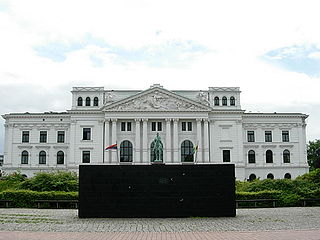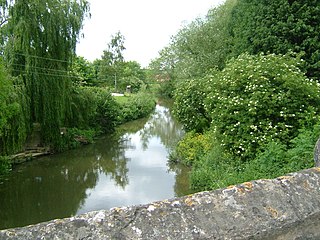
Wissahickon Creek is a tributary of the Schuylkill River in Montgomery and Philadelphia Counties, Pennsylvania in the United States.

Altona is the westernmost urban borough (Bezirk) of the German city state of Hamburg, on the right bank of the Elbe river. From 1640 to 1864 Altona was under the administration of the Danish monarchy and Denmark's only real harbour directly to the North Sea. Altona was an independent city until 1937. In 2016 the population was 270,263.

Devil's Bridge is a village and community in Ceredigion, Wales. Above the River Mynach on the edge of the village is the unusual road bridge from which the village gets its English name.

Saint Kilian, also spelled Killian, was an Irish missionary bishop and the Apostle of Franconia, where he began his labours towards the end of the 7th century. His feast day is July 8.

Chester Racecourse, known as the Roodee, is according to official records the oldest racecourse still in use in England. Horse racing at Chester dates back to the early sixteenth century. It is also thought to be the smallest racecourse of significance in England at 1 mile and 1 furlong (1.8 km) long.

The Molawin River, also referred to as the Molawin Creek, is one of the many low volume flowing rocky streams crisscrossing the campus of the University of the Philippines Los Baños and some areas of the town of Los Baños. Molawin Creek crosses the whole of the UPLB campus and essentially cuts it in half making it necessary to construct several bridges throughout the University's history to improve the campus' integrity and general accessibility. Volume of flow depends on the average rainfall of the season and develops into a raging river during typhoons or heavy rainfall. It is a minor tributary of Laguna Lake, one among many small creeks that empty into Laguna de Bay. The origins of Molawin Creek and the other creeks in Los Baños have not been pinpointed but are generally accepted to have their origins high up in Mount Makiling. The name Molawin is a local variation of the name of the Molave tree.

The River Beult is a tributary of the River Medway in South East England. It has several sources west of Ashford, including one at Woodchurch. It then flows through Headcorn. At Hunton, 7 furlongs (1.4 km) above Yalding it is joined by the major stream of the River Teise. Town bridge lies 10 1⁄4 miles (16.5 km) from Allington, it is the longest mediaeval bridge in Kent. The river enters the Medway at Yalding. The River Beult is crossed by the railway between Headcorn and Staplehurst. The bridge was the scene of the Staplehurst rail crash in 1865 in which Charles Dickens was involved..
The city of Hamburg in Germany is made up of seven boroughs and subdivided into 104 quarters. Most of the quarters were former independent settlements. As of 2008 the areal organisation is regulated by the constitution of Hamburg and several laws.

Othmarschen is a quarter in the Altona borough of the Hamburg in northern Germany. In 2016 the population was 14,893.

Nienstedten is a quarter in the city of Hamburg, Germany. It belongs to the Altona borough on the right bank of the Elbe river. Nienstedten is home to the International Tribunal for the Law of the Sea. In 2016 the population was 7,238.

Osdorf is a quarter in the city of Hamburg, Germany. It belongs to the Altona borough. In 2016 the population was 26,140.

The Loki-Schmidt-Garten, also known as Botanischer Garten Hamburg, or, more formally, as Botanischer Garten der Universität Hamburg or Biozentrum Klein Flottbek und Botanischer Garten, is a botanical garden maintained by the University of Hamburg. It has a size of around 25 hectares and is located at Ohnhorststrasse 18, Hamburg, Germany, beside the Klein Flottbek station in the Osdorf quarter, and open daily without charge. It was renamed in 2012 after Loki Schmidt, the wife of the former German chancellor Helmut Schmidt. Though it was renamed, the old name coexists with the new one. Nearby Klein Flottbek station still has the second name "Botanischer Garten".
The Jenisch park is the oldest landscaped park in Hamburg, Germany, located in the Othmarschen quarter at the Geest shore of River Elbe. Of the area of 43 ha, 8 are a protected. Two museums, Jenisch House and Ernst Barlach House, are located within the park. The river Flottbek flows through the park and into the Elbe at Teufelsbrück.

The Bode Gorge is a 10 kilometres (6.2 mi) long ravine that forms part of the Bode valley between Treseburg and Thale in the Harz Mountains of central Germany. The German term, Bodetal, is also used in a wider sense to refer to the valleys of the Warme and Kalte Bode rivers that feed the River Bode.

Spodnja Bilpa is a small settlement on the left bank of the Kolpa River in the Municipality of Kočevje in southern Slovenia. The area is part of the traditional region of Lower Carniola and is now included in the Southeast Slovenia Statistical Region.

The Lutheran Nienstedten Cemetery is a church-operated historic burial ground in Hamburg, Germany. The cemetery is owned by the Evangelical Lutheran parish church of Nienstedten, Hamburg. The cemetery is located on the Elbchaussee near the parish church in Nienstedten, now a Hamburg suburb. It is one of the oldest cemeteries still in operation in the Greater Hamburg area with around 250 burials taking place each year.
The Elbchaussee is a famous thoroughfare of Hamburg, Germany, joining the city's western Elbe suburbs (Elbvororte) Othmarschen, Nienstedten and Blankenese with Altona and Hamburg's inner city. Running along the elevated northern Elbe shore, across Geest heights, embedded forests and meadows, the Elbchaussee offers scenic views across the widening Lower Elbe, onto the opposite plains of Altes Land, and the distant activities of the port's container terminals.

Groß Flottbek, is a quarter of Hamburg, Germany, in the borough of Altona. It is located in the center of the borough north of the Othmarschen quarter. Near Groß Flottbek, the neighbourhood of Klein Flottbek, which is not an official quarter, can be found. Around 11.000 people live in Groß Flottbek on 2.4 sq km.

Klein Flottbek is a sub-urban district and neighbourhood in the quarters of Nienstedten, Othmarschen and Osdorf, located in the Altona borough of Hamburg, Germany. Unlike neighbouring Groß Flottbek, the former municipality of Klein Flottbek is not an official quarter of Hamburg today.






















